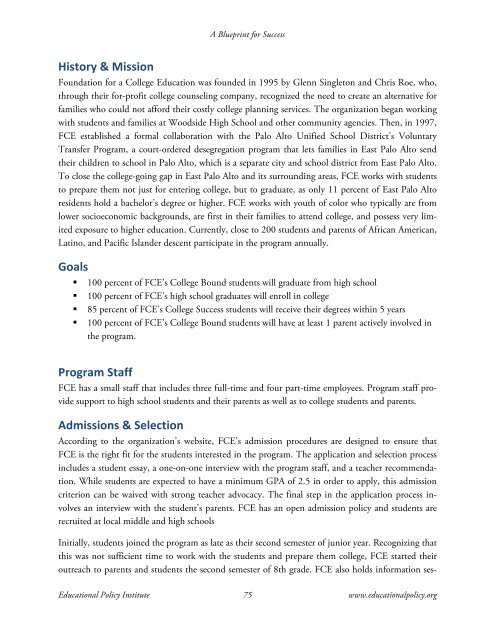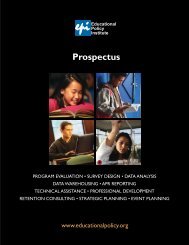A BluePrint for Success: Case Studies of Successful - Educational ...
A BluePrint for Success: Case Studies of Successful - Educational ...
A BluePrint for Success: Case Studies of Successful - Educational ...
Create successful ePaper yourself
Turn your PDF publications into a flip-book with our unique Google optimized e-Paper software.
History & Mission<br />
A Blueprint <strong>for</strong> <strong>Success</strong><br />
Foundation <strong>for</strong> a College Education was founded in 1995 by Glenn Singleton and Chris Roe, who,<br />
through their <strong>for</strong>-pr<strong>of</strong>it college counseling company, recognized the need to create an alternative <strong>for</strong><br />
families who could not af<strong>for</strong>d their costly college planning services. The organization began working<br />
with students and families at Woodside High School and other community agencies. Then, in 1997,<br />
FCE established a <strong>for</strong>mal collaboration with the Palo Alto Unified School District’s Voluntary<br />
Transfer Program, a court-ordered desegregation program that lets families in East Palo Alto send<br />
their children to school in Palo Alto, which is a separate city and school district from East Palo Alto.<br />
To close the college-going gap in East Palo Alto and its surrounding areas, FCE works with students<br />
to prepare them not just <strong>for</strong> entering college, but to graduate, as only 11 percent <strong>of</strong> East Palo Alto<br />
residents hold a bachelor’s degree or higher. FCE works with youth <strong>of</strong> color who typically are from<br />
lower socioeconomic backgrounds, are first in their families to attend college, and possess very limited<br />
exposure to higher education. Currently, close to 200 students and parents <strong>of</strong> African American,<br />
Latino, and Pacific Islander descent participate in the program annually.<br />
Goals<br />
100 percent <strong>of</strong> FCE’s College Bound students will graduate from high school<br />
100 percent <strong>of</strong> FCE’s high school graduates will enroll in college<br />
85 percent <strong>of</strong> FCE’s College <strong>Success</strong> students will receive their degrees within 5 years<br />
100 percent <strong>of</strong> FCE’s College Bound students will have at least 1 parent actively involved in<br />
the program.<br />
Program Staff<br />
FCE has a small staff that includes three full-time and four part-time employees. Program staff provide<br />
support to high school students and their parents as well as to college students and parents.<br />
Admissions & Selection<br />
According to the organization’s website, FCE’s admission procedures are designed to ensure that<br />
FCE is the right fit <strong>for</strong> the students interested in the program. The application and selection process<br />
includes a student essay, a one-on-one interview with the program staff, and a teacher recommendation.<br />
While students are expected to have a minimum GPA <strong>of</strong> 2.5 in order to apply, this admission<br />
criterion can be waived with strong teacher advocacy. The final step in the application process involves<br />
an interview with the student’s parents. FCE has an open admission policy and students are<br />
recruited at local middle and high schools<br />
Initially, students joined the program as late as their second semester <strong>of</strong> junior year. Recognizing that<br />
this was not sufficient time to work with the students and prepare them college, FCE started their<br />
outreach to parents and students the second semester <strong>of</strong> 8th grade. FCE also holds in<strong>for</strong>mation ses-<br />
<strong>Educational</strong> Policy Institute 75 www.educationalpolicy.org




